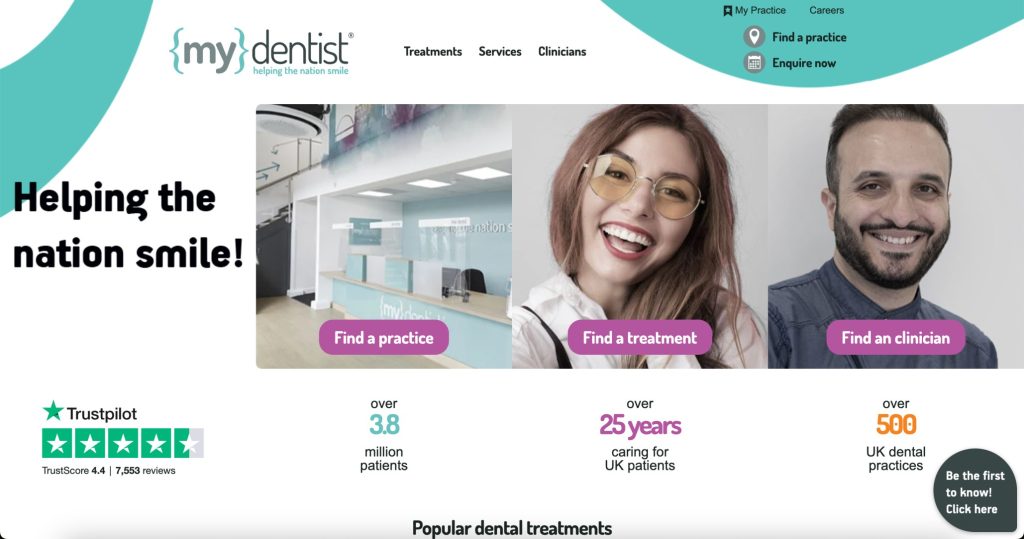In today’s competitive dental industry, implementing effective marketing strategies is essential for practice growth and patient acquisition. Modern dental practices must combine digital innovation with traditional marketing approaches to create a comprehensive strategy that resonates with potential patients.
This guide explores 15 practical dental marketing strategies that have demonstrated consistent results for practices across the UK. From optimising your online presence to refining your patient experience, these approaches will help you attract new patients while retaining your existing client base.
Why Dental Marketing Matters More Than Ever
The dental market has become increasingly competitive, with patients having more options than ever before. According to recent industry data, the average person searches for a new dentist only once every 3-5 years. This means your practice needs to be visible and compelling when that search happens.
Moreover, approximately 70% of potential patients now begin their search for a dentist online, making digital marketing essential to practice growth. However, successful dental marketing requires more than just maintaining a website—it demands a strategic approach across multiple channels.
Let’s explore the most effective dental marketing strategies for 2025.
1. Develop a Patient-Focused Website
Your website serves as the digital front door to your practice and is often the first impression potential patients have of your services. A well-designed dental website should:
- Load quickly: 53% of visitors abandon websites that take longer than three seconds to load
- Be mobile-responsive: Over 60% of dental website visits now come from mobile devices
- Feature clear calls-to-action: Make it obvious how visitors can book appointments
- Showcase before/after galleries: Visual evidence of your work builds trust
- Include patient testimonials: Real feedback creates credibility
- Offer online booking: Convenience drives conversions
When designing your website, focus on the patient journey. Consider what information they need and how they’ll navigate through your site. Clear service descriptions, transparent pricing information, and accessible contact details are essential components.
Additionally, incorporating a blog section allows you to address common dental concerns and demonstrate your expertise. Articles like “What to Expect During a Root Canal” or “How to Care for New Veneers” provide value to readers while improving your search visibility.

2. Optimise for Local Search
For dental practices, local search engine optimisation (SEO) is crucial. When potential patients search for “dentist near me” or “dentist in [your city],” you want your practice to appear at the top of the results.
To improve your local SEO:
- Claim and optimise your Google Business Profile: Complete all information, add photos, and update your hours regularly
- Ensure NAP consistency: Your Name, Address, and Phone number should be identical across all online platforms
- Create location-specific pages: If you serve multiple areas, create dedicated pages for each location
- Earn local backlinks: Partner with local businesses or sponsor community events to build local authority
- Use local keywords: Incorporate location-specific terms throughout your website content
Research shows that 76% of people who conduct a local search on their smartphone visit a business within 24 hours. By optimising for local search, you position your practice to capture these high-intent potential patients.

3. Implement a Review Management Strategy
Online reviews significantly influence patient decisions, with 88% of consumers trusting online reviews as much as personal recommendations. A strategic approach to review management includes:
- Actively requesting reviews: Develop a system for asking satisfied patients to share their experiences online
- Responding to all reviews: Address both positive and negative feedback professionally
- Highlighting positive reviews: Feature testimonials on your website and social media
- Addressing negative feedback: Use criticism as an opportunity to demonstrate your commitment to patient satisfaction
- Monitoring review platforms: Stay aware of what’s being said about your practice across various sites
Remember that Google’s algorithm considers both the quantity and recency of reviews. Consistently gathering new reviews signals to search engines that your practice is active and trusted.
4. Create Valuable Educational Content
Content marketing establishes your dental expertise while addressing potential patients’ questions and concerns. Effective content:
- Addresses common questions: Create articles answering frequently asked questions about dental procedures
- Explains complex procedures: Break down complicated treatments into understandable terms
- Provides preventative advice: Share tips for maintaining oral health between visits
- Uses various formats: Incorporate blogs, videos, infographics, and downloadable guides
- Includes relevant keywords: Optimise content for terms your potential patients are searching for
When creating content, focus on providing genuine value rather than overtly promoting your services. A blog post about “5 Ways to Prevent Gum Disease” is more likely to engage readers than one titled “Why Our Gum Disease Treatment Is the Best.”
According to content marketing research, dental practices that blog consistently receive 67% more leads than those that don’t. Quality content attracts visitors, builds trust, and guides potential patients through their decision-making process.
5. Leverage Social Media Strategically
Social media offers dental practices a platform to showcase their personality, share educational content, and engage with the community. Different platforms serve different purposes:
- Facebook: Ideal for community building, event promotion, and patient education
- Instagram: Perfect for visual content like before/after photos and team highlights
- LinkedIn: Valuable for professional networking and industry recognition
- YouTube: Excellent for educational videos and virtual office tours
Rather than attempting to maintain a presence on every platform, focus on one or two channels where your target patients are most active. Post consistently and engage with followers through likes, comments, and direct messages.
Effective social media content for dental practices includes:
- Team introductions: Humanise your practice by featuring staff members
- Behind-the-scenes glimpses: Show your practice culture and environment
- Patient success stories: Share transformations (with permission)
- Dental tips and advice: Provide easily digestible oral health information
- Community involvement: Highlight your participation in local events
Remember that social media is primarily about building relationships rather than direct promotion. The most successful dental social media accounts maintain an 80/20 balance—80% educational or entertaining content and 20% promotional material.
6. Implement Email Marketing
Email marketing remains one of the most cost-effective dental marketing strategies, with an average return of £42 for every £1 spent. A well-structured email programme helps you:
- Stay connected with current patients: Regular newsletters keep your practice top-of-mind
- Reactivate dormant patients: Special offers can encourage overdue patients to schedule appointments
- Educate your audience: Share oral health tips and practice updates
- Promote new services: Introduce new treatments or technology
- Generate referrals: Encourage patients to refer friends and family
Segment your email list for more targeted communication. Categories might include:
- New patients
- Patients due for check-ups
- Patients who’ve expressed interest in cosmetic procedures
- Parents of children who are patients
- Older adults who might need specific treatments
Personalised emails generate 41% higher click-through rates than generic messages. Use patients’ names and reference their specific dental history or needs when appropriate (while maintaining HIPAA compliance).
7. Invest in Pay-Per-Click Advertising
While organic strategies build long-term visibility, pay-per-click (PPC) advertising delivers immediate results. Google Ads allows you to target potential patients actively searching for dental services in your area.
To maximise your PPC effectiveness:
- Target specific procedures: Focus on high-value treatments like implants or clear aligners
- Use location targeting: Limit your ads to your service area
- Create dedicated landing pages: Direct clicks to pages specifically designed for conversion
- Implement call tracking: Monitor which keywords generate phone calls
- Continuously optimise: Regularly review performance and adjust your strategy
The average cost per click for dental keywords ranges from £2 to £15, depending on location and competition. However, with the lifetime value of a dental patient often exceeding £2,000, even expensive clicks can deliver excellent ROI when campaigns are properly managed.
8. Develop a Referral Programme
Patient referrals typically convert at a higher rate than other marketing channels. A formalised referral programme encourages existing patients to recommend your practice to others.
Elements of an effective dental referral programme include:
- Clear incentives: Offer rewards for both the referrer and the new patient
- Simple process: Make it easy for patients to refer others
- Regular promotion: Remind patients about your referral programme
- Staff involvement: Train your team to mention the programme appropriately
- Tracking system: Monitor which patients are generating referrals
Common referral incentives include treatment discounts, free teeth whitening, electric toothbrushes, or gift cards. Whatever you choose, make sure the reward is valuable enough to motivate action while remaining profitable for your practice.
9. Leverage Video Marketing
Video content is increasingly important for dental marketing, with 72% of consumers preferring to learn about services through video rather than text. Effective dental videos include:
- Virtual practice tours: Show off your facility and technology
- Procedure explanations: Reduce patient anxiety by walking through what to expect
- Patient testimonials: Feature satisfied patients sharing their experiences
- Meet the team: Introduce staff members to build familiarity
- Oral health tips: Share quick advice for maintaining dental health
Videos don’t need to be professionally produced to be effective. Authentic, informative content often performs better than overly polished productions that may feel impersonal.
Share your videos across multiple platforms, including your website, YouTube channel, social media profiles, and email newsletters. This maximises reach while improving engagement across all your marketing channels.
10. Partner with Local Businesses
Building relationships with complementary businesses in your community can expand your reach and credibility. Consider partnerships with:
- Medical professionals: Physicians, ENTs, and paediatricians
- Wellness providers: Nutritionists, fitness centres, and wellness spas
- Schools and community organisations: Sports teams, educational institutions, and community centres
- Local employers: Businesses looking to provide wellness benefits to employees
Mutually beneficial partnerships might include:
- Cross-referrals: Formal agreements to refer clients to each other
- Co-hosted events: Joint wellness workshops or educational sessions
- Shared content: Guest posts on each other’s blogs or newsletters
- Co-branded materials: Collaborative educational resources
Local partnerships not only generate direct referrals but also strengthen your local SEO through community connections and potential backlinks.
11. Offer Membership Plans
Dental membership plans provide an alternative to traditional insurance and can attract both uninsured patients and those seeking better value. A well-structured membership plan:
- Creates predictable revenue: Subscription payments provide steady monthly income
- Improves patient retention: Members are more likely to remain loyal to your practice
- Encourages regular visits: Included cleanings and exams promote preventative care
- Simplifies financial discussions: Clear pricing eliminates insurance complications
- Differentiates your practice: Not all dental offices offer membership options
Typical membership plans include bi-annual cleanings, examinations, and X-rays, plus discounts on additional treatments. Price points vary by market but generally range from £15-£30 per month for adult plans.
Promote your membership plan on your website, in your office, and through targeted campaigns to uninsured patients. Many practices find that membership plans quickly become one of their most profitable marketing initiatives.
12. Use Patient Personas to Target Marketing
Understanding who your ideal patients are allows you to create more targeted, effective marketing. Develop detailed patient personas by considering:
- Demographics: Age, income, family status, location
- Treatment needs: Preventative care, restorative work, cosmetic procedures
- Pain points: Cost concerns, dental anxiety, time constraints
- Media consumption: Where they spend time online, what content they engage with
- Decision factors: What influences their choice of dentist
For example, a “Cosmetic Cathy” persona might be a professional woman in her 40s who’s interested in smile enhancement and values quality over cost, while “Prevention Paul” might be a family-oriented man in his 30s who prioritises preventative care for his children and is price-sensitive.
Once you’ve defined your key personas, tailor your marketing messages and channels to address their specific needs and preferences. This targeted approach typically generates higher conversion rates than generic marketing.
13. Enhance the Patient Experience
Your existing patients are your most valuable marketing asset. By creating an exceptional experience, you generate positive reviews, referrals, and loyalty.
Focus on improving:
- Front desk interactions: Train staff to be welcoming and efficient
- Waiting environment: Create a comfortable, appealing space with amenities
- Communication: Keep patients informed about what to expect
- Treatment experience: Prioritise comfort and clear explanations
- Follow-up procedures: Check in after significant treatments
- Billing processes: Make payment options clear and convenient
Small touches—like remembering personal details, celebrating milestones, or providing unexpected amenities—can transform a standard appointment into a memorable experience that patients want to share with others.
Research indicates that it costs 5-25 times more to acquire a new patient than to retain an existing one. Investing in patient experience improvements often delivers a higher ROI than many external marketing efforts.

14. Implement Marketing Automation
Marketing automation tools help dental practices maintain consistent communication with patients while saving staff time. Automated processes can include:
- Appointment reminders: Reduce no-shows with automated text or email reminders
- Review requests: Send review invitations at optimal times after appointments
- Reactivation campaigns: Contact patients who haven’t visited in 6+ months
- Birthday and holiday greetings: Build rapport with personalised messages
- Treatment follow-ups: Check in after procedures to monitor satisfaction and recovery
Many dental practice management systems now include basic marketing automation features, or you can integrate with dedicated platforms like Mailchimp, HubSpot, or dental-specific solutions.
Start with simple automation workflows and expand as you become comfortable with the technology. Even basic automation can significantly improve your marketing consistency and results.
15. Track and Analyse Marketing Performance
Without proper tracking, it’s impossible to know which dental marketing strategies are working. Implement systems to monitor:
- New patient sources: How patients discovered your practice
- Website analytics: Traffic sources, behaviour, and conversion rates
- Social media metrics: Engagement, growth, and referral traffic
- Email performance: Open rates, click-through rates, and conversions
- Return on investment: Cost per new patient acquisition by channel
Use this data to refine your marketing strategy, allocating more resources to high-performing channels and improving or eliminating underperforming initiatives.
Set clear key performance indicators (KPIs) for each marketing channel and review them monthly. Common dental marketing KPIs include:
- Number of new patients
- Cost per new patient acquisition
- Website conversion rate
- Social media engagement rate
- Patient retention rate
By consistently tracking these metrics, you’ll develop a data-driven marketing approach that maximises your return on investment.
Implementing Your Dental Marketing Strategy
With so many potential strategies, it’s easy to feel overwhelmed. Rather than attempting to implement all 15 strategies simultaneously, take a phased approach:
- Start with the fundamentals: Optimise your website, Google Business Profile, and review management system
- Add patient communication channels: Implement email marketing and social media
- Expand your digital presence: Develop content marketing and consider PPC advertising
- Enhance patient experience and referrals: Create formal programmes to improve satisfaction and generate referrals
- Refine with advanced strategies: Add video marketing, partnerships, and membership plans
Remember that consistency is more important than perfection. A simple strategy executed consistently will outperform a complex plan that’s implemented sporadically.
Common Dental Marketing Mistakes to Avoid
As you develop your dental marketing plan, be aware of these common pitfalls:
- Focusing solely on new patients: Neglecting retention marketing to existing patients
- Inconsistent branding: Mixed messages across different marketing channels
- Ignoring metrics: Failing to track which strategies are working
- Outdated website: Maintaining a website that doesn’t reflect current standards
- Overlooking mobile users: Not optimising for the growing segment of mobile searchers
- Neglecting online reviews: Failing to actively manage your online reputation
- Generic messaging: Not differentiating your practice from competitors
By avoiding these mistakes and implementing the strategies outlined above, you’ll create a comprehensive dental marketing plan that drives practice growth.
Conclusion: Building a Sustainable Marketing System
Effective dental marketing isn’t about implementing the latest trend or quick fix. Instead, it’s about building a systematic approach that consistently attracts and retains ideal patients.
The most successful dental practices combine digital innovation with timeless marketing principles—providing exceptional service, communicating clearly, and delivering genuine value to patients. By implementing these 15 proven strategies, you’ll create a marketing system that supports sustainable practice growth.
Remember that dental marketing is a marathon, not a sprint. The practices that achieve the best results are those that commit to consistent, strategic marketing efforts over time rather than expecting immediate results from sporadic activities.
Key Takeaways
- A patient-focused website forms the foundation of effective dental marketing
- Local SEO is essential for capturing high-intent searches from potential patients
- Patient experience drives reviews and referrals—your two most valuable marketing assets
- Content marketing establishes expertise and builds trust with potential patients
- Targeted marketing based on patient personas delivers higher conversion rates
- Consistent tracking allows for data-driven marketing decisions
- A systematic, phased approach yields better results than trying to do everything at once
Frequently Asked Questions About Dental Marketing Strategies
How much should a dental practice spend on marketing?
Most successful dental practices invest between 5-8% of their annual revenue in marketing activities. New practices or those in highly competitive markets may need to allocate closer to 10-12% initially to establish their presence. Start with foundational elements like a professional website and local SEO before expanding into paid advertising channels. Track your cost per new patient acquisition across different channels to optimise your marketing budget allocation over time.
Which marketing channels are most effective for dentists?
The most effective dental marketing channels vary based on your target patient demographics and practice goals. However, data consistently shows that an optimised website with strong local SEO, an active Google Business Profile, and a systematic review generation process form the foundation of successful dental marketing. For patient acquisition, Google Ads and Facebook advertising frequently deliver the lowest cost per new patient. For retention, email marketing typically provides the highest ROI. The key is implementing proper tracking to determine which channels work best for your specific practice and patient base.
How can dentists measure marketing ROI?
To accurately measure dental marketing ROI, implement these tracking methods: 1) Ask and record how each new patient found your practice, 2) Use unique phone numbers or tracking codes for different marketing channels, 3) Set up goal tracking in Google Analytics for online appointment requests, 4) Calculate the lifetime value of your average patient, and 5) Divide your marketing costs by the number of new patients acquired through that channel. Additionally, consider tracking key indicators like website conversion rate, cost per click for paid advertising, and patient retention rates. Proper attribution is essential—some channels may assist conversions without being the final touchpoint in the patient journey.
How important are online reviews for dental practices?
Online reviews are extremely influential in dental practice growth. Research shows that 87% of potential patients read online reviews when selecting a new dentist, and practices with ratings below 4 stars see significantly fewer new patient enquiries. Beyond influencing patient decisions, reviews also impact your Google search rankings. Practices with more positive, recent reviews typically rank higher in local search results. Implementing a systematic approach to generating reviews (such as post-appointment automated requests) is one of the highest-ROI marketing activities for dental practices. Remember to respond professionally to all reviews—both positive and negative—as your responses also influence potential patients.
Should dental practices handle marketing in-house or outsource it?
The decision to handle marketing in-house or outsource depends on your practice size, budget, and internal capabilities. Most successful dental practices use a hybrid approach. Keep patient-facing elements like social media content and email communications in-house, as these benefit from your team’s authentic voice and patient relationships. Consider outsourcing technical aspects like website development, SEO, and paid advertising management to specialists. These areas require specific expertise and constant adaptation to changing algorithms and best practices. Start by assessing your team’s strengths and time limitations. Even with outsourced marketing, someone within your practice should oversee the strategy and serve as the point person for your marketing partners.
| Marketing Strategy | Cost Level | Time to Results | Best For | Typical ROI |
|---|---|---|---|---|
| Website Optimisation | ££-£££ | 1-3 months | All practices | High |
| Local SEO | ££ | 3-6 months | All practices | Very High |
| Google Ads | £££ | Immediate | New practices, competitive markets | Medium-High |
| Social Media | £-££ | 3-6 months | Practices targeting younger demographics | Medium |
| Email Marketing | £ | 1-3 months | Patient retention | Very High |
| Content Marketing | ££ | 6-12 months | Authority building | High |
| Video Marketing | ££-£££ | 1-3 months | Building trust, explaining procedures | Medium-High |
| Review Management | £ | 1-3 months | All practices | Very High |
| Membership Plans | ££ | 3-6 months | Practices with uninsured patients | High |
| Referral Programme | £-££ | 2-4 months | Established practices | Very High |



